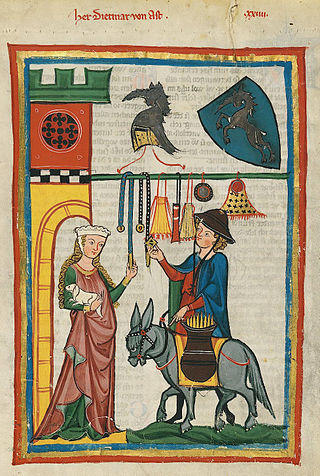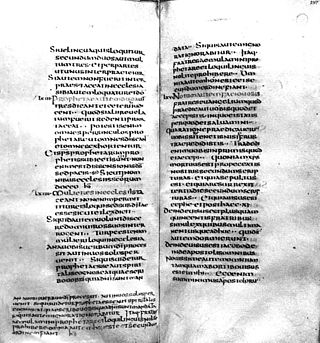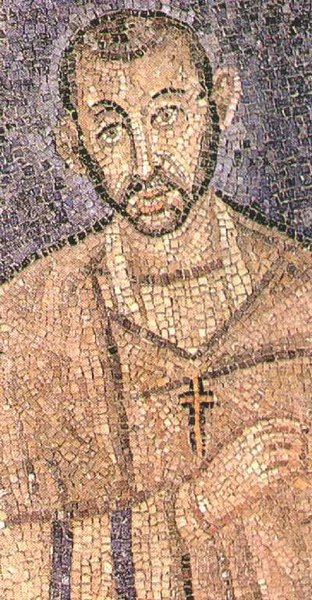Related Research Articles

Boniface, OSB was an English Benedictine monk and leading figure in the Anglo-Saxon mission to the Germanic parts of Francia during the eighth century. He organised significant foundations of the church in Germany and was made bishop of Mainz by Pope Gregory III. He was martyred in Frisia in 754, along with 52 others, and his remains were returned to Fulda, where they rest in a sarcophagus which remains a site of Christian pilgrimage.

Donar's Oak was a sacred tree of the Germanic pagans located in an unclear location around what is now the region of Hesse, Germany. According to the 8th century Vita Bonifatii auctore Willibaldo, the Anglo-Saxon missionary Saint Boniface and his retinue cut down the tree earlier in the same century. Wood from the oak was then reportedly used to build a church at the site dedicated to Saint Peter. Sacred trees and sacred groves were widely venerated by the Germanic peoples.

Saint Lullus was the first permanent archbishop of Mainz, succeeding Saint Boniface, and first abbot of the Benedictine Hersfeld Abbey. He is historiographically considered the first official sovereign of the Electorate of Mainz.

Dietmar von Aist was a Minnesinger from a baronial family in the Duchy of Austria, whose work is representative of the lyric poetry in the Danube region.

The Codex Fuldensis, also known as the Victor Codex, designated by F, is a New Testament manuscript based on the Latin Vulgate made between 541 and 546. The codex is considered the second most important witness to the Vulgate text; and is also the oldest complete manuscript witness to the order of the Diatessaron. It is an important witness in any discussion about the authenticity of 1 Corinthians 14:34–35 and the Comma Johanneum. It is one of the earliest dated manuscripts of the New Testament. It was corrected until 2 May, 546 AD.

Heinrich von Bibra, Prince-Bishop, Prince-Abbot of Fulda (1711–1788) was Prince-Bishop and Prince-Abbot from 1759 to 1788. As part his role as Prince-Abbot of Fulda, he had the additional role as Archchancellor (Erzkanzler) of the Holy Roman Empress.

Rudolf Simek is an Austrian philologist and religious studies scholar who is Professor and Chair of Ancient German and Nordic Studies at the University of Bonn. Simek specializes in Germanic studies, and is the author of several notable works on Germanic religion and mythology, Germanic peoples, Vikings, Old Norse literature, and the culture of Medieval Europe.

The Institute for the Study and Elimination of Jewish Influence on German Church Life was a cross-church establishment by eleven German Protestant churches in Nazi Germany, founded at the instigation of the German Christian movement. It was set up in Eisenach under Siegfried Leffler and Walter Grundmann. Georg Bertram, professor of New Testament at the University of Giessen, who led the Institute from 1943 until the Institute's dissolution in May 1945, wrote about its goals in March 1944: "'This war is Jewry's war against Europe.' This sentence contains a truth which is again and again confirmed by the research of the Institute. This research work is not only adjusted to the frontal attack, but also to the strengthening of the inner front for attack and defence against all the covert Jewry and Jewish being, which has oozed into the Occidental Culture in the course of centuries, ... thus the Institute, in addition to the study and elimination of the Jewish influence, also has the positive task of understanding the own Christian German being and the organisation of a pious German life based on this knowledge."
Heinrich Ludwig Julius Heppe was a German Calvinist theologian and church historian.
The Treaty of Dorpat (Tartu) was concluded in May 1564, during the Livonian War. Ivan IV of Russia accepted the subordinance of Reval (Tallinn) and some Livonian castles to Erik XIV of Sweden, and in turn Erik XIV accepted the subordinance of the rest of Livonia to Ivan IV. Subsequently, Russia and Sweden agreed on a seven-years' truce.
Theodor Schieffer was a German historian. He was professor of medieval history at the University of Mainz, then at the University of Cologne, and since 1952 he was president of the Association for Middle Rhine Church History. He is the author of Winfrid-Bonifatius und die christliche Grundlegung Europas, the authoritative biography of Saint Boniface.

The Ragyndrudis Codex is an early medieval codex of religious texts, now in Fulda in Germany, which is closely associated with Saint Boniface, who, according to tradition, used it at the time of his martyrdom to ward off the swords or axes of the Frisians who killed him on 5 June 754 near Dokkum, Friesland. This long association has given the codex the status of a contact relic.

De bono mortis is a sermon by St. Ambrose (340–397), a Doctor of the Church. The text, which argues that death is not a bad thing to be feared, was written between 387 and 391. A companion piece or supplement to his De Iacob, it was composed "as two sermons, perhaps for the catechumens awaiting baptism at Easter". Profoundly informed by neoplatonism, it is one of the texts through which Augustine of Hippo, Ambrose's pupil in Milan, came under the influence of that philosophy.
Petra Kehl is a German scholar of the Middle Ages, specifically of the veneration of saints. Kehl's monograph Kult und Nachleben des hl. Bonifatius (1993) is one of two monographs on the veneration of Saint Boniface. Her study was praised by one reviewer as written "with meticulous care", and by another as "an account that deserves wide recognition, a standard for scholarship for years to come". Kehl lives in Fulda, where she runs a publishing company specializing in historical fiction, religious literature, and children's literature.
Horst Wolfgang Böhme is a German archaeologist with a focus on Late Antiquity / Early Middle Ages and research into castles.

Eisenach Charterhouse is a former charterhouse, or Carthusian monastery, in Eisenach in Thüringia, Germany, founded in 1378 and suppressed in 1525.
Klaus Zechiel-Eckes was a German historian and medievalist.
Walter Salmen was a German musicologist and university lecturer. Salmen taught from 1958 to 1992 as a professor of musicology at the Saarland University and the University of Kiel. Afterwards, he was for many years the full professor of the Musicological Institute of the University of Innsbruck. As a guest lecturer, he also worked in Switzerland, Israel and the United States. After retirement, he lived in Kirchzarten near Freiburg im Breisgau, and worked as honorary professor at the University of Freiburg.
Kurt Kluxen was a German historian. From 1963 to 1979 Kluxen taught as a full professor for middle and modern history at the University of Erlangen-Nuremberg. He became known to a wider audience mainly through his History of England.
Peter Herde is a German historian. His research activities range from fundamental work on papal diplomatics of the Middle Ages to the history of the country up to the Second World War.
References
- ↑ Skwortz, Sascha (20 February 2013). "Mittelalter: Ein 'finsteres' Kapitel? Abschiedsvorlesung von Prof. Dr. Lutz v. Padberg an der FTH". Gießener Zeitung (in German). Retrieved 23 September 2014.
- ↑ Linnemann, Eta (2001). Historical Criticism of the Bible: Methodology Or Ideology? Reflections of a Bultmannian Turned Evangelical. Kregel Academic. pp. 49, 70. ISBN 9780825430954.
- ↑ Hauke, Manfred (1995). God Or Goddess? Feminist Theology: What is it? Where Does it Lead?. Ignatius. pp. 14, 44, 133. ISBN 9780898705591.
- 1 2 Heidrich, Ingrig (1996). "Rev. of von Padberg, Mission und Christianisierung". Historische Zeitschrift . 263 (2): 458–60. JSTOR 27631078.
- 1 2 Aaij, Michel (June 2005). "Continental Business: Boniface Biographies". The Heroic Age (8). Archived from the original on 22 July 2020. Retrieved 18 October 2020.
- 1 2 Aaij, Michel (May 2007). "Boniface's Booklife: How the Ragyndrudis Codex Came to be a Vita Bonifatii". The Heroic Age (10). Archived from the original on 20 July 2020. Retrieved 18 October 2020.
- 1 2 Kloft, Matthias Th. (2000). "Rev. of von Padberg, Studien zur Bonifatiusverehrung". Historische Zeitschrift . 270 (2): 451–54. JSTOR 27633235.
- ↑ Sombek, Theo; Vering, Axel; Willert, Albrecht (1993). Das Bild von der Welt in Naturwissenschaft und Theologie. Vandenhoeck & Ruprecht. pp. 15–17. ISBN 9783525776018.
- ↑ Drout, Michael D. C. (2007). J.R.R. Tolkien Encyclopedia: Scholarship and Critical Assessment. Taylor & Francis. p. 405. ISBN 9780415969420.
- ↑ Eldevik, John (2012). Episcopal Power and Ecclesiastical Reform in the German Empire: Tithes, Lordship, and Community, 950–1150. Cambridge UP. p. 117. ISBN 9781139535991.
- ↑ Engels, Christoph (2006). "Rev. of Von Padberg, Christianisierung im Mittelalter". Archäologische Informationen . 29 (1&2). doi:10.11588/ai.2006.1&2.11114.